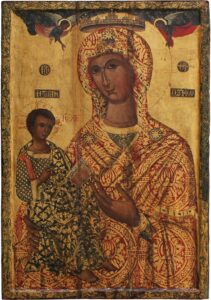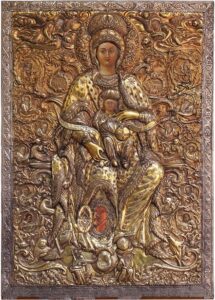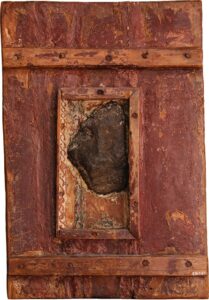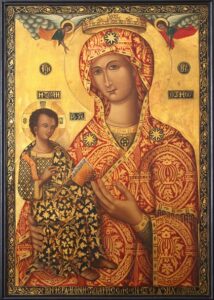THE MIRACULOUS ICON OF PANAGIA TROODITISSA

The miraculous icon of Theotokos with the inscription “MH(TH)P Θ(EO)Y H TPOOΔHOTHCCA” (“MOTHER OF GOD, THE TROODITISSA”).
The centrepiece of the Monastery is the big, miracle-making icon of Theotokos, painted on cedar wood. Theotokos is shown dexiokratousa [holding the infant Jesus with her right hand] with the inscription “ΜΗ(ΤΗ)Ρ Θ(ΕΟ)Υ Η ΤΡΟΟΔΗΟΤΗCCΑ” [MOTHER OF GOD, THE TROODITISSA].

Panagia, a silver gilt work of Ioannis Kornaros (1799).
The present form of the miraculous icon is dated to the first decades of the 17th c. Attributed to Solomon Thytes (namely priest), great icon-painter of the time, it is an overpaint of the original icon: special scientists adamantly believe that the wood upon which the icon has been drawn is dated to several centuries before that.
This old icon was decorated with silver in 1799, during the days of Metropolitan Sophronios of Pafos (1790-1805), by Cretan icon-painter Ioannis Kornaros, at the expense of Nicosia head priest, Christodoulos Myriantheos. The gilding, by the subvention of Nicodemus, then Hegumen of the Monastery, was the work of a craftsman named Theodosios.

The reverse side of the miraculous icon of Trooditissa with he tone.
This particular icon of Panagia Trooditissa was long associated with the conviction of the faithful that if a childless woman were to stand before it and pray for a child, her wish would be granted. There are several testimonies about miracles attributed to Panagia Trooditissa, for instance the case of a Christian Orthodox from Beirut, named Ioannis, and his wife. The couple came to the Monastery to pray to Theotokos for a child. They promised, as was customary then, if the child was a boy, to dedicate it to the Monastery as a monk. Panagia hearkened to their fervent prayer and they had a son. When the boy grew up, his parents brought him to the Monastery, honouring their pledge.

Panagia Trooditissa, a replica of the miraculous icon (1951).
A few years later, the parents came back to the Monastery, this time to take their only son back. The child did not wish to leave the Monastery. The parents insisted until something miraculous happened: in the midst of their argument, a large stone fell off the old wall of the church and rolled toward the boy’s head. The miraculous icon of Panagia immediately moved from its place to cover the child and absorb the impact. Seeing how their son’s life was saved, the parents respected his wish. He grew up to be a monk and stayed at the Monastery until the day he died.
In commemoration of this miracle, the stone was attached to the back of the icon, which (icon) remains to this day the Monastery’s most precious sacred relic.
This ancient icon was temporarily detached from its silver-gilt revetment in 1951, in order to be copied by icon-painter and present-day Hegumen, Athanasios. Years later, on 4 March 1997, the silver-gilt revetment was again removed, this time permanently, and placed on an icon-stand on the south wall, next to the templon. The old icon was kept in its initial place, next to the Beautiful Gates.